目录
1. 二叉树创建字符串

- 此题先遍历左子树,再遍历右子树即可
- 问题在于如何判断在什么时候加括号:如果该节点左边为空,右不为空,则左边括号保留。如果左边为空,右边也为空,那么左右括号都不保留。如果左边不为空,右边为空,则右边括号不保留


- 创建string型变量str,将每一个节点的int 数据to_string为string类型,再由递归层层向下,最终在return之后str全都加起来
class Solution {
public:
string tree2str(TreeNode* root) {
if (root == nullptr)
return "";
string str = to_string(root->val);
//如果该节点左边为空,右不为空,则左边括号保留
//如果左边不为空,右边为空,则右边括号不保留
if (root->left || root->right)
{
str += '(';
str += tree2str(root->left);
str += ')';
}
if (root->right)
{
str += '(';
str += tree2str(root->right);
str += ')';
}
return str;
}
};2. 给定一个二叉树, 找到该树中两个指定节点的最近公共祖先
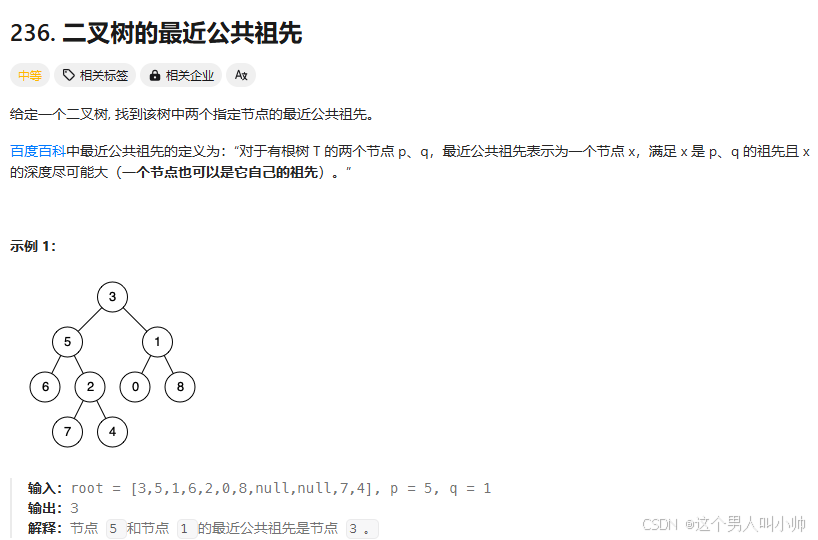

- 如果为三叉链结构(含有父亲节点指针),那么求解公共祖先非常简单,类似求双交链表,将parent指针视为next指针,让底层的节点先走差距步,然后再一个一个的比较,当两个节点相遇时该节点就是公共祖先
- 如果是普通的二叉链式结构, 通过find查找p、q是在左还是在右。因为只要存在一个节点,p、q分别在它的左子树和右子树,那么该节点就是p、q的最近公共祖先!


- 如果root节点是p或q,那么root就是公共祖先(自己可以是自己的祖宗)

class Solution {
public:
bool find(TreeNode* r, TreeNode* x)
{
if (r == nullptr)
return false;
return r == x || find(r->left, x) || find(r->right, x);
}
TreeNode* lowestCommonAncestor(TreeNode* root, TreeNode* p, TreeNode* q) {
if (root == nullptr)
return nullptr;
if (root == p || root == q)
return root;
bool pInLeft, pInRight, qInLeft, qInRight;
pInLeft = find(root->left, p);
pInRight = !pInLeft;
qInLeft = find(root->left, q);
qInRight = !qInLeft;
if (pInLeft && qInLeft)
{
return lowestCommonAncestor(root->left, p, q);
}
else if (pInRight && qInRight)
{
return lowestCommonAncestor(root->right, p, q);
}
else
{
return root;
}
}
};该算法时间复杂度是什么?
O(N*N),猜测该树状结构为最坏情况,全都在一条分支,每一次都find,最坏在高度次找到

如何优化到 O(N) ?
使用前序遍历,用stack来记录到达p、q路径上的节点(比较相等时,比较指针,因为树内可能有相等的值),最后转化为类似相交链表的问题
左右都找不到,那么就pop掉该节点的,因为该节点不在p、q的路径上

//方法二:前序遍历获取p、q路径,用stack记录路径上节点,最后转化为相交链表问题
bool FindPath(TreeNode* root, TreeNode* x, stack<TreeNode*>& path)
{
if (root == nullptr)
return false;
path.push(root);
if (root == x)
return true;
if (FindPath(root->left, x, path))
return true;
if (FindPath(root->right, x, path))
return true;
//左右都找不到,就会到这里,那么就pop掉该节点的,因为该节点不在p、q的路径上
path.pop();
return false;
}
TreeNode* lowestCommonAncestor(TreeNode* root, TreeNode* p, TreeNode* q)
{
stack<TreeNode*> pPath, qPath;
FindPath(root, p, pPath);
FindPath(root, q, qPath);
while (pPath.size() > qPath.size())
{
pPath.pop();
}
while (pPath.size() < qPath.size())
{
qPath.pop();
}
while (pPath.top() != qPath.top())
{
pPath.pop();
qPath.pop();
}
return qPath.top();
}3. 二叉树搜索树转换成排序双向链表

在诸多要求下,该如何链接?
创建两个指针,prev、cur,然后采用中序遍历(中序遍历的顺序就是双链表的顺序),cur先走,prev在后,到达一个节点时,它的上一个节点 prev 的 right 链接 cur,cur 的 left 链接 prev,然后更新prev,继续递归
在中序遍历时,要注意参数prev的类型,是TreeNode*的引用!这是为了在树最底层的栈帧中prev被更新返回上一个函数栈帧后,prev也是新的,可以被使用
链接完成后,找到左子树最左节点,该节点就是head,返回该节点就是答案
class Solution {
public:
void InOrder(TreeNode* cur, TreeNode*& prev)
{
if (cur == nullptr)
return;
//中序遍历
InOrder(cur->left, prev);
//开始链接
cur->left = prev;
if (prev)
prev->right = cur;
//更新prev,注意参数要用&,因为所有递归函数要用统一的prev,prev更新之后可以立即使用
prev = cur;
InOrder(cur->right, prev);
}
TreeNode* Convert(TreeNode* pRootOfTree)
{
TreeNode* prev = nullptr;
InOrder(pRootOfTree, prev);
TreeNode* head = pRootOfTree;
while (head && head->left)
head = head->left;
return head;
}
};4. 根据一棵树的前序遍历与中序遍历构造二叉树
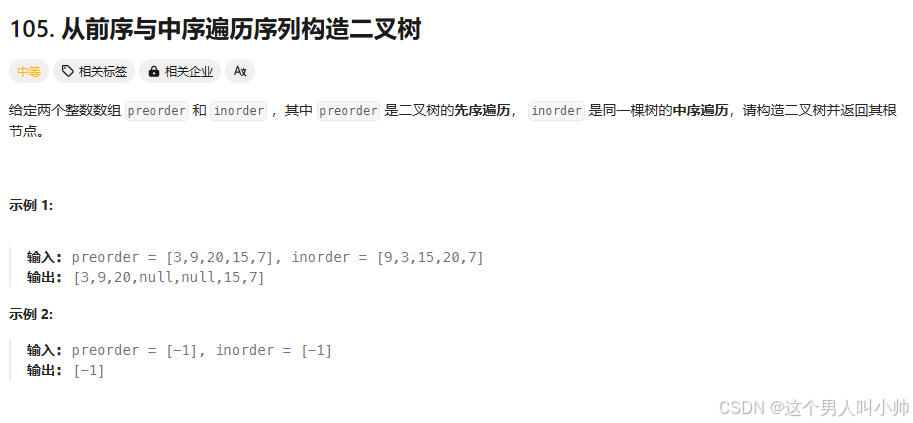
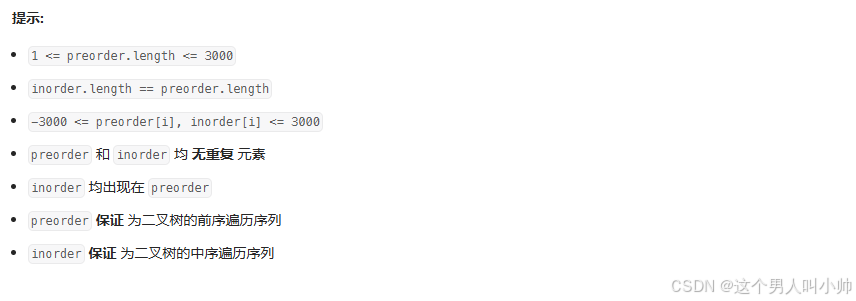
前序序列(根 左子树 右子树):用来确定根
- 中序序列(左子树 根 右子树):根据根来分割左右区间,当区间不存在时分割完成
- 让控制先序遍历数组的下标 prei 一直往后走,再在中序遍历的数组中找到对应的值,根据这个值的下标分割数组,将子区间各自递归下去
class Solution {
public:
TreeNode* _buildTree(vector<int>& preorder, vector<int>& inorder, int& prei,
int inbegin, int inend)
{
//如果区间不存在,则分割完成
if (inbegin > inend)
return nullptr;
TreeNode* root = new TreeNode(preorder[prei]);
//在中序数组内找,prei对应的根
int rooti = inbegin;
while (rooti <= inend)
{
if (inorder[rooti] == preorder[prei])
break;
++rooti;
}
//往后走,分割区间继续递归
++prei;
//链接是从低到顶链接的,即递归到最底往上的时候开始链接
//[inbegin, rooti - 1] rooti [rooti + 1, inend]
root->left = _buildTree(preorder, inorder, prei, inbegin, rooti - 1);
root->right = _buildTree(preorder, inorder, prei, rooti + 1, inend);;
return root;
}
TreeNode* buildTree(vector<int>& preorder, vector<int>& inorder)
{
int i = 0;
TreeNode* root = _buildTree(preorder, inorder, i, 0, inorder.size() - 1);
return root;
}
};5. 根据一棵树的中序遍历与后序遍历构造二叉树

- 同理,有中序和后序,由于后序(左子树 右子树 根)的特性,控制下标从后往前走,并先构建右子树
class Solution {
public:
TreeNode* _buildTree(vector<int>& inorder, vector<int>& postorder, int& posti, int inbegin, int inend)
{
if (inbegin > inend)
return nullptr;
TreeNode* root = new TreeNode(postorder[posti]);
int rooti = inbegin;
while (rooti <= inend)
{
if (inorder[rooti] == postorder[posti])
break;
++rooti;
}
--posti;
root->right = _buildTree(inorder, postorder, posti, rooti + 1, inend);
root->left = _buildTree(inorder, postorder, posti, inbegin, rooti - 1);
return root;
}
TreeNode* buildTree(vector<int>& inorder, vector<int>& postorder)
{
int i = postorder.size() - 1;
TreeNode* root = _buildTree(inorder, postorder, i, 0, inorder.size() - 1);
return root;
}
};
6. 二叉树的前序遍历,非递归迭代实现 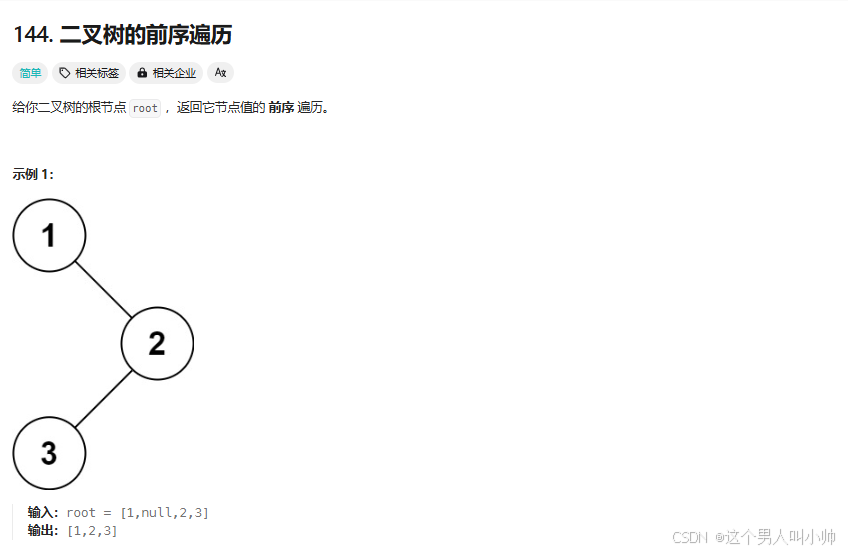
- 访问一棵树,分为两部分:左路节点,左路节点的右子树,这一点很重要,有递归思想,是解题关键
- 用栈来实现前序遍历,将左路节点的指针入栈,将访问的值存入vector
- 开始访问右子树时先将栈顶元素出栈,以子问题的方式访问右子树,循环起来
依托于栈的特性,后进先出,使得访问顺序就是前序

class Solution {
public:
vector<int> preorderTraversal(TreeNode* root)
{
stack<TreeNode*> st;
TreeNode* cur = root;
vector<int> v;
while (cur || !st.empty())
{
//访问一颗树的开始
//访问左路节点,将所有root的所有左路节点入栈,后序在访问左路节点的右子树
while (cur)
{
v.push_back(cur->val);
st.push(cur);
cur = cur->left;
}
//依次访问左路节点的右子树
TreeNode* top = st.top();
st.pop();
//以子问题的方式访问右子树
cur = top->right;
}
return v;
}
};7. 二叉树中序遍历 ,非递归迭代实现
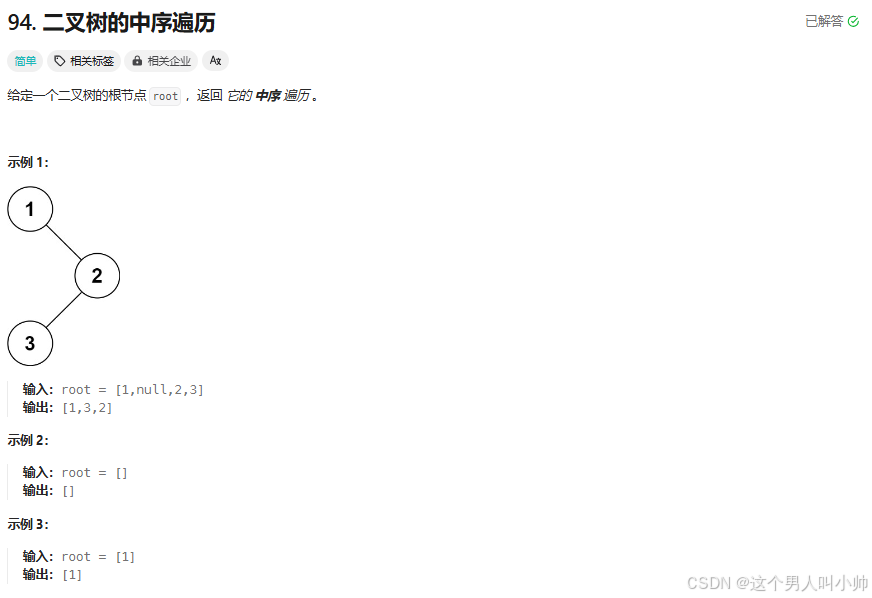
- 很简单,将v的push_back放在出栈时就可以打到中序遍历的效果
- 从栈里面pop一个节点,意味着这个节点的左子树已经访问完了
class Solution {
public:
vector<int> inorderTraversal(TreeNode* root)
{
stack<TreeNode*> st;
TreeNode* cur = root;
vector<int> v;
while (cur || !st.empty())
{
//访问一颗树的开始
//访问左路节点,将所有root的所有左路节点入栈,后序在访问左路节点的右子树
while (cur)
{
st.push(cur);
cur = cur->left;
}
//依次访问左路节点的右子树
TreeNode* top = st.top();
st.pop();
v.push_back(top->val);
//以子问题的方式访问右子树
cur = top->right;
}
return v;
}
};8. 二叉树的后序遍历 ,非递归迭代实现

- 按照后序遍历,如果一个节点的右子树没有访问过(正准备访问),那么它的上一个访问节点是左子树的根;如果让的右子树已经访问过了(刚刚访问完),那么它的上一个访问节点是右子树的根
- 所以后序遍历的访问时机就是,如果该节点访问到第二次了,那么这个节点的val就要被push_back进vector中了,或者如果该节点没有右子树,那么这个节点的val也要被push_back进vector中
- 所以如何判断该节点已经访问过两次了?答案就是用prev记录上一个已经访问的节点!
- 一个节点的右子树为空或者上一个访问的节点是右子树的根,都说明该节点的右子树已经访问完了,可以访问当前节点了!

class Solution {
public:
vector<int> postorderTraversal(TreeNode* root) {
stack<TreeNode*> st;
vector<int> v;
TreeNode* prev = nullptr;
TreeNode* cur = root;
while (cur || !st.empty())
{
//访问一颗树的开始
//访问左路节点,将所有root的所有左路节点入栈,后序在访问左路节点的右子树
while (cur)
{
st.push(cur);
cur = cur->left;
}
TreeNode* top = st.top();
//一个节点的右子树为空或者上一个访问的节点是右子树的根
//都说明该节点的右子树已经访问完了,可以访问当前节点了!
if (top->right == nullptr || top->right == prev)
{
prev = top;
v.push_back(top->val);
st.pop();
}
else cur = top->right;
}
return v;
}
};























 892
892

 被折叠的 条评论
为什么被折叠?
被折叠的 条评论
为什么被折叠?








